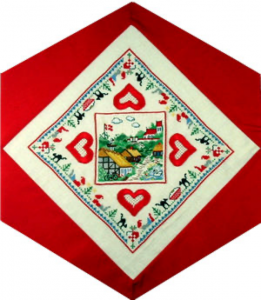Denmark

The Block
Denmark plays a leading role in embroidered arts, using both ancient traditions and modern innovations. The central scene of this block is similar to the stylized patterns that appear on bell pulls, pillow covers and wall hangings found in most Danish homes. Based on a painting by Michael Fog that was transferred into a cross-stitch pattern by Jetta Blair, it depicts a typical village on a Sunday morning. Stitchers Inge Nielsen and Rosa Christensen brought the scene to life. A flag flutters in the breeze, a bicycle rests against the home (bicycles are a popular form of transportation in Denmark), and a country kirk (church) rises high in the distance.
The four hearts surrounding the scene are done in Hedebo embroidery. This form of openwork originated in Denmark. The block’s cross-stitch border features the popular Christmas theme and includes such symbols as elves, trees, cats and bowls of risengrod (rice pudding). Many Danes follow the tradition of feeding the pudding to cats at Christmas time, while some children put a bowl of it under their beds for the nisse (elves) before they go to sleep. If the nisse have not eaten the pudding by morning, the children believe they will receive no presents.
Cultural Profile
Denmark, a constitutional monarchy in northwestern Europe, is the southernmost of the Scandinavian countries. It is home to Legoland Park, which displays miniaturized buildings created from thousands of Lego blocks. The popular toy bricks originated in this country and continue to delight and fuel the imagination of children worldwide. It is also the birthplace of famous story teller, Hans Christian Andersen, whose works have been translated into more languages than any other book except the Bible.
Denmark is a leader in pollution control and preservation of the environment. It was the first industrialized nation to establish a ministry of the environment.
The country is famous for its beautifully designed ceramics, silverware, stemware, kitchenware and porcelain. Danish design is admired for its an uncluttered, minimal aesthetic sensibility and it is evident in the Danish architecture and furniture as well. Some Danish Modern designs have become iconic over the past decades, such as the colourful Panton chair, the Egg seat or the Swan chairs. The design and making of furniture remains an industry that plays a central part in the nation’s economy.
Denmark also has a long-standing heritage of spinning, weaving and knitting. The Vikings needed sails for their longboats, which women wove out of wool on vertical warp-weighted wooden looms — a type of loom which allowed the production of almost unlimited sizes of fabric since the weavers didn’t need to sit. The sails were then water-proofed with horse fat and dyed with raw ochre pigment to prevent rot. It is believe that it could take up to one year of work for two women to make one sail. Tablet-weaving was also used extensively in Denmark to produce bands and ribbons to decorate clothing. Danes continue to weave household linens and items of clothing.
The population of Denmark is comprised almost entirely of ethnic Danes but includes several other minority groups as well. Danish is the official language, although English is the predominant second language spoken. Interestingly enough, Danish, Swedish and Norwegian are mutually intelligible languages. Danes, known for their spontaneity and friendliness, pride themselves on being thoroughly modern and open-minded, and for this reason, wearing folk costumes, celebrating traditional festivals and practicing old-fashioned customs is less prevalent here than in other parts of Europe. The Danish perspective on life is embodied in the concept of hygge (cozy and snug), in which the turmoil and troubles of the outside world are shut out in favour of a warm, intimate gathering.
Danes began coming to Canada in 1864 with major waves occurring from the late 1880s to 1914, the 1920s and the 1950s and 1960s. New Denmark, the oldest Danish settlement in Canada, was established in New Brunswick in 1872 and is still home to some Danish speakers. The first Danish settlement on the Canadian Prairies was founded in Dickson, Alberta, in 1903. Danes, now located in all of Canada’s provinces and territories, have formed social clubs, built churches and published newspapers. They have made significant contributions to Canada in many areas, particularly the dairy industry, nurseries, the co-operative movement and gymnastics, and were among the first to build homes for senior citizens. As of 2011, over 203,000 Canadians were recorded as being of Danish origin.
Sponsor: Royal Danish Embassy, Danish Canadian Society Montreal, Inc., Danish Club of Montreal
